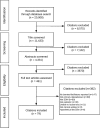Barriers and facilitators of pediatric shared decision-making: a systematic review
- PMID: 30658670
- PMCID: PMC6339273
- DOI: 10.1186/s13012-018-0851-5
Barriers and facilitators of pediatric shared decision-making: a systematic review
Abstract
Background: Shared decision-making (SDM) is rarely implemented in pediatric practice. Pediatric health decision-making differs from that of adult practice. Yet, little is known about the factors that influence the implementation of pediatric shared decision-making (SDM). We synthesized pediatric SDM barriers and facilitators from the perspectives of healthcare providers (HCP), parents, children, and observers (i.e., persons who evaluated the SDM process, but were not directly involved).
Methods: We conducted a systematic review guided by the Ottawa Model of Research Use (OMRU). We searched MEDLINE, EMBASE, Cochrane Library, CINAHL, PubMed, and PsycINFO (inception to March 2017) and included studies that reported clinical pediatric SDM barriers and/or facilitators from the perspective of HCPs, parents, children, and/or observers. We considered all or no comparison groups and included all study designs reporting original data. Content analysis was used to synthesize barriers and facilitators and categorized them according to the OMRU levels (i.e., decision, innovation, adopters, relational, and environment) and participant types (i.e., HCP, parents, children, and observers). We used the Mixed Methods Appraisal Tool to appraise study quality.
Results: Of 20,008 identified citations, 79 were included. At each OMRU level, the most frequent barriers were features of the options (decision), poor quality information (innovation), parent/child emotional state (adopter), power relations (relational), and insufficient time (environment). The most frequent facilitators were low stake decisions (decision), good quality information (innovation), agreement with SDM (adopter), trust and respect (relational), and SDM tools/resources (environment). Across participant types, the most frequent barriers were insufficient time (HCPs), features of the options (parents), power imbalances (children), and HCP skill for SDM (observers). The most frequent facilitators were good quality information (HCP) and agreement with SDM (parents and children). There was no consistent facilitator category for observers. Overall, study quality was moderate with quantitative studies having the highest ratings and mixed-method studies having the lowest ratings.
Conclusions: Numerous diverse and interrelated factors influence SDM use in pediatric clinical practice. Our findings can be used to identify potential pediatric SDM barriers and facilitators, guide context-specific barrier and facilitator assessments, and inform interventions for implementing SDM in pediatric practice.
Trial registration: PROSPERO CRD42015020527.
Keywords: Barriers; Facilitators; Implementation; Ottawa Model of Research Use; Pediatrics; Shared decision-making; Systematic review; Taxonomy.
Conflict of interest statement
Ethics approval and consent to participate
Not applicable.
Consent for publication
Not applicable.
Competing interests
All authors declare that they have no competing interests.
Publisher’s Note
Springer Nature remains neutral with regard to jurisdictional claims in published maps and institutional affiliations.
Figures




References
-
- Harrison C. Treatment decisions regarding infants, children and adolescents. Position statement Paediatr Child Heal Can Pediatr Soc. 2004;9(2):99–103. https://www.ncbi.nlm.nih.gov/pmc/articles/PMC2720471/. - PMC - PubMed
Publication types
MeSH terms
Grants and funding
LinkOut - more resources
Full Text Sources
Medical
Miscellaneous

